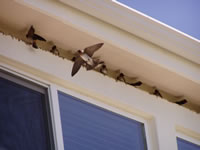![]()
We Accept
![]()
![]()
![]()
Cash
&
Check
Call toll free 877-4ABOLISH
877-422-6547

Gallery 1 2 3 4 5 6 Video
Abolish your Swallow Problems!
Abolish Provides a wide range of Swallow Pest Control Services. We are professionals when it comes to dealing with Swallows. We only use the best products and abide by all laws when dealing with all animals. read below for more on Swallows and what we do. We Do RESIDENTIAL, COMMERCIAL, and Industrial Swallow control--Check the Service Area
Swallow Control | Proofing | Laws | Nest Removal | Identification | Damage
Swallow mud nests damage and deface the outer walls and eaves of residences and office buildings. They are as much an eye sore as they are a hazard. These insect infested mud nest can ruin the architectural appearance of your building or home. If they are left on the building long enough staining will occur. Once swallows leave, nests are left vacant and new tenants appear (sparrows). In addition to leaving their nests, swallows also leave their parasites behind. Without hosts, these insects tend to move in to your home to find new hosts. Ideally, swallow prevention is recommended. Call us to take care of your Swallow problem before the swallow prevention window is missed. No company will be able to legally remove the nests if it is occupied by swallows and their eggs.
There are many swallow proofing products and techniques used to prevent swallows from nesting. The proofing is usually done after legal removal of the swallow's nest is finished. Many pest control companies use netting, wire, and scare techniques. Abolish uses a more effective proofing product without visually sacrificing your homes exterior. The use of nets, bird gel and wiring is not only ineffective at times, it is also unpleasant to the eye. Abolish is a certified BirdSlide installer. Birdslide is the effective way of preventing Swallows from nesting.
Swallow Control by Birdslide TM
One of the most innovative and effective Swallow control products we use is called BirdslideTM. Birdslide is used for ledges and under eaves to prevent roosting birds or nesting Swallows. For swallows, Birdslide can be used upside down under eaves to exclude the birds. Our technicians are well trained in the use of this product.
topRemoval of swallow nests must be timed accordingly to their migration departure. Since swallows are a protected species, so are their nests. Therefore the nests should not be removed until swallows have migrated south and vacated their nests. Once the nests are vacant it is safe to rid your self from that unwanted nest and their parasites. The swallow nests harbor many swallow parasites ticks, fleas and bedbugs. So prior to removal, decontaminations is recommended. After it has been decontaminated we can begin to pressure wash the nasty nests. As soon as the nests have been removed it is recommended that a swallow prevention product is installed to prevent future mishaps.top
Swallows and their nests are fully protected under the Migratory Bird Treaty Act of 1918, which makes it illegal to intentionally kill, injure or take any migratory bird. It is illegal to intentionally damage or destroy the nest, eggs, or young of a swallow while it is being built or in use. The Act allows fines or prison sentences for every bird, egg or nest destroyed.
Cliff swallows and barn swallows are slender, sleek birds that spend their spring and summers in North America. Swallows are very territorial and will return to the same nesting site over and over. Buildings, eaves and other structures often replace cliffs these days to build their distinctive mud pellet nests (see photo at right). Swallows have brownish red faces and light colored bellies. Cliff swallows have squared off tails, but barn swallows have long forked tails (see top photo). Young swallows have similar coloring, but lighter.
Swallows are small birds with dark glossy backs, red throats, pale under parts and long distinctive tail streamers. They are extremely agile in flight and spend most of their time on the wing. They are widespread breeding birds in the Northern Hemisphere, migrating south in winter. Recent declines due to loss of habitat quality in both their breeding and wintering grounds mean they are an Amber List species.
Amber-list species are those with an unfavorable conservation status in Europe; those whose population or range has declined moderately in recent years; those whose population has declined historically but made a substantial recent recovery; rare breeders; and those with internationally important or localized populations.
Swallows feed on insects and spend a large part of each day in the air catching flies, beetles, and mosquitoes. Their long pointed wings give them great speed and maneuverability. Normally, swallows are not seen on the ground except when collecting mud for their nests. Most do not have musical voices but only twitter or squeak.
The cliff swallow is 5 to 6 inches in length and is the only square-tailed swallow in California. In contrast, its long, deeply forked tail distinguishes the barn swallow. The cliff swallow is also recognized by its pale, orange-brown rump, white forehead, dark rust-colored throat, and steel blue crown and back.
These small, nimble birds enjoy special legal protection. Once they have laid their eggs in the nest, you can not disturb them. You must wait until they leave to remove the nests and then exclude them using BirdSlide installed along the underside of the eaves at an angle to prevent them from building their nests there the following year.
topSwallows are often a nuisance in suburban areas as they build their mud nests that damage and deface the outer walls and eaves of residences and office buildings. Swallow feces often end up on the sides of buildings and the ground below from the colony of birds in residence. Building owners report extra clean up costs and concern over slip and fall liability from swallow dropping buildup, plus an unclean, dirty company image. The bacteria, fungal agents and parasites found in swallow droppings and nests can carry hosts with serious diseases, including histoplasmosis, encephalitis, salmonella, meningitis, toxoplasmosis and more.
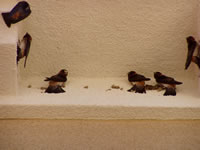
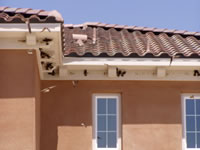
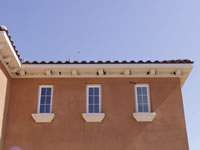
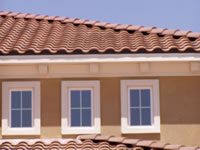
home
| specials | commercial
| residential | service
area
preparation | pests
| feedback | contact
us
Abolish Pest Control . Absolutely no rights of distribution by sale or other transfer of
ownership or by rental, lease or lending, preparation of derivative works,
or reproduction, in whole or in part, is not granted. No text, graphics
or photos may be downloaded and used on another Internet site, without
express permission of AbolishPestControl. For information on obtaining
photo useage and rights, please see our contact
page. AbolishPestControl reserves the rights to actively protect against
infringement. swallow nest removal swallow proofing, netting, prevention
and swallow control
Copyright ©1985 - 2019 AbolishPestControl.com All Rights Reserved



